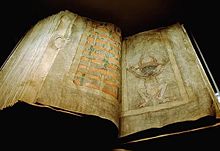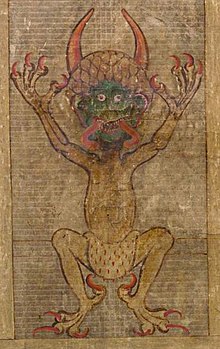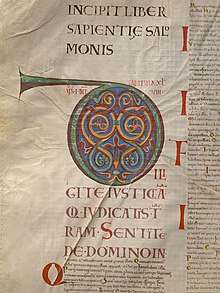Codex Gigas
The Codex Gigas is one of the largest handwritten books in the world (hence the name Gigas , Greek for "huge"). The giant Bible was probably written in the Benedictine monastery of Podlažice in Bohemia in the early 13th century and is also known as the Devil's Bible , which is based on a famous full-page illustration of the devil on fol. 290r in the Code . The book is written in Latin .
Appearance
The codex is bound in a wooden envelope with a leather cover and metal ornaments. At 92 cm high, 50 cm wide and 22 cm thick, it is the largest known medieval manuscript. Today it consists of 310 parchment - and two sheets of paper. Eight other sheets are missing. It is not known who took the pages; they presumably contained Benedictine disciplinary rules. The codex weighs almost 75 kg. The script is a Carolingian minuscule . Scripture analysis suggests that the Code was only written by a person whose name is unknown. The mention of a hermanus inclusus ("Hermann the Hermit", probably a monk in cloister ) in the text could be an indication of the author.
history
As things stand today, the code was written in the Benedictine monastery in Podlažice, which was destroyed by the Hussites in the 15th century . The records in the codex end in 1229. The codex was brought to the Cistercian monastery Sedletz (Czech: Sedlec) in 1245 and in 1477 to the Benedictine monastery in Breunau (Czech: Břevnov), where it was kept in the monastery library until 1593. Then it was added to the Prague collection of curiosities of Emperor Rudolf II .
In the final year of the Thirty Years' War , when Prague was sacked, the entire collection, including Codex Gigas and Codex Argenteus , was confiscated as spoil by the Swedish army . The Stockholm Royal Library has kept the manuscript since 1649 . In 2007 she loaned the book to the Prague Clementinum , where it was on view from September 2007 to March 2008.
content
About half of the Codex is the copy of the complete Bible , largely based on the Vulgate , while Acts and Apocalypse follow a translation of the Vetus Latina from before 350 . It also contains Isidore of Seville's Etymologiae , Flavius Josephus ' Antiquitates Judaicae , the Chronica Boemorum des Cosmas of Prague , various tracts (on history , etymology and physiology ), a calendar, a list of brothers of the monastery, miracles and other local records.
The manuscript contains many book illuminations in red, yellow, green and gold. Initials are carefully designed, often over entire pages. The style of the Code is consistent, and the way it is written shows no change due to age, illness or mood. This may be a reason to believe that the book was finished in a short time (see also the legend).
Sheet 289r shows a very famous image of the devil, about 50 centimeters high. On some pages before and after the text is in two columns on a dark background in light font, which distinguishes it from the rest of the book. On some of these pages only the two-column deposit is carried out, but no text has been written. The text on the other pages is easy to moderately legible, depending on the degree of preservation of the font.
The codex has been supplemented several times over the years, the deaths of the Brenau brothers Johannes and Andreas were entered in the calendar, as was a visit by Emperor Ferdinand to the monastery. In addition, a number of people who were allowed to inspect the codex have also been immortalized in the manuscript.
Legend
According to a legend, the core of which can already be recognized in a catalog entry from 1635, the code was written by a monk who broke the rules of discipline and was therefore condemned to be walled up alive. In order for him to be released from this severe punishment, he promised to write a book in praise of the monastery in a single night, which should contain all human knowledge. Near midnight he realized that he could not do this job alone and sold his soul to the devil. The devil completed the manuscript and the monk added the image of the devil to indicate the true author.
The translation of the presumed author's mention of hermanus inclusus as "trapped Hermann" is incorrect, it rather points to a hermit monk.
literature
- Stanislav Bártl, Jiří Kostelecký: Ďáblova bible. Tajemství největší knihy světa. Paseka, Prague 1993, ISBN 80-85192-64-0 .
- Codex Gigas - the Devil's bible. Prague, National Library of the Czech Republic, 2007, ISBN 978-80-7050-533-5 , ISBN 978-80-7050-532-8
Web links
- Digitized version of the manuscript: Link
- Codex Gigas - Full description on the website of the National Library of Sweden
- Codex Gigas in The European Library : preciousness of the National Library of Sweden (English)
- A video (2:42 minutes) shows a presentation of the Codex Gigas on YouTube
- Documentation about the Codex Gigas on veoh.com
Individual evidence
- ↑ This is shown by a note on fol. 1v.
- ↑ Reporting at Focus Link and Welt Link .
- ↑ Fol. 308r , 309v , 304r .
- ↑ Felix von Linda, fol. 309v . Georg Barthold Potanus, fol. 305v.



